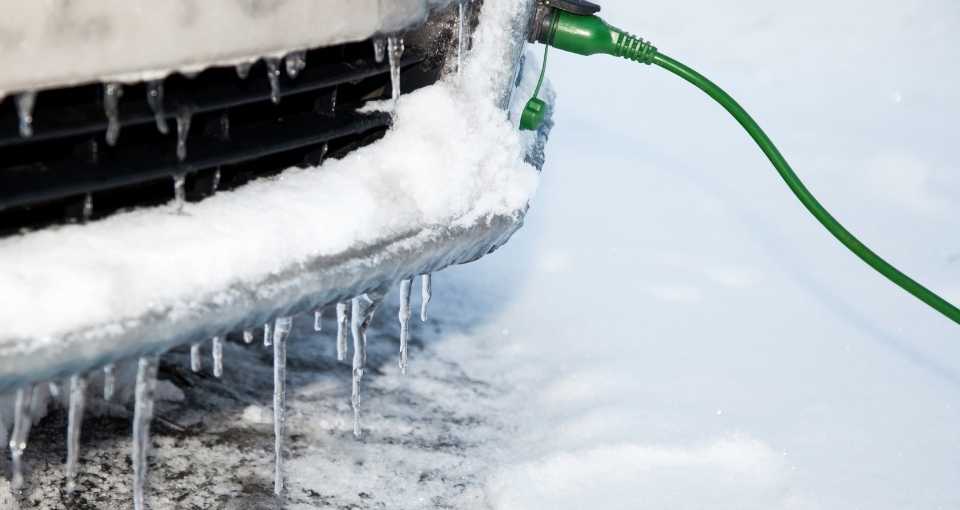Having a block heater has many benefits during the cold winter months. One being you can start your car without have to wait as long to warm the engine.
If you had your engine block heater plugged in during the night. Then your engine will startup much easier in extreme cold temperatures. So in the morning your ready to go.
Having your block heater plugged in and starting your car at the same time is not going to cause any damage. So you can either get in your car and turn the ignition or start your car remotely while keeping the block heater plugged in. Just make sure to unplug before driving off.
If you need to run the cable with the hood of your car open. Then your remote start will not typically work with an opened hood.
Since a block heater will only warm the engine up to a certain point without the engine running. Then your still left with a cold car interior and no heat running.
So the advantage to starting the car with the block heater still plugged in. Is to further warm the engine up to operating temperature. So when you get in you can turn on the heat (if you didn’t leave it turned on) and get going.
I would recommend leaving your heat dial turned on during cold months. Especially if you plan to remote start the car. A lot of newer cars will automatically heat or cool the cars interior when you remote start it.
I believe you still have to leave the auto air setting on though.
What Is An Engine Block Heater?
A block heater is a small device that works to keep engine temperatures warm enough to not freeze during the winter. They are designed to be used on vehicles sitting outside on extremely cold temperatures.
You will want to use one when the temperature is at 0 degrees or below. They not only help to get your engine started in these cold temperatures. But also prolong the life of your motor as it doesn’t undergo as much stress from cold starts.
There is a few different types of engine heaters. Such as engine block heater, oil pan heater and transmission heater. Oil and transmission heaters can be interchangable as it depends on where you place it.
Also the oil or transmission heaters can either be outside pads/blankets or submersible which is what an engine block heater is. Engine block heaters have a coil or element that is submersed in the coolant.
You could also have a setup where you have a engine block heater, a oil pan heater and a transmission heater installed.
The most common type of heater is an engine block heater. This is what a lot of vehicle models with winter packages include. A lot of trucks or SUV’s come with them installed such as Ford, Chevy and Jeeps.
The size and how much electricity they use depends on the engine size. Engine block heaters typically range from 400 watts to 1000.
| Block Heater Power | Engine Type |
| 400 Watts | 4 Cylinder |
| 600 Watts | 6 Cylinder |
| 700-800 Watts | 8 Cylinder |
| 1000 Watts | V10’s and Diesel engines |
You can also buy aftermarket engine block heaters, but you need to buy one that will fit your specific car brand and model. Otherwise you can purchase engine heating pads/blankets.
Engine heating pads are designed to stick onto either your oil pan or other fluid reservoirs. It must be placed onto a smooth surface in order to stay on and work properly.
Engine block heaters and heating pads run off electricity but are separate from your car’s battery power. The block heater will have a cable and plug which looks like any other regular outlet cable.
Most of the time you need an extension cord to reach a nearby outlet. Since manufactures don’t want to have a long cable stuffed in the engine compartment.
Some trucks will have a small compartment on the front bumper where you can easily access the cord to plug in.
How Engine Heaters Work
Engine block heaters are commonly used to heat a vehicles coolant. I know it sounds backwards. Since a coolant is used to keep the engine from overheating.
In this case when a vehicle is sitting outside in extreme cold weather. The coolant will nearly freeze and become thick. Making engine start up more difficult.
Engine coolant also never stays that cool in the first place. Normal coolant temperature is between 190 to 220 degrees.
So it makes since that the coolant can be used to heat a engine in the winter months. Engine block heaters heat the coolant which is present throughout a engine in was is called water jackets.
Coolant basically surrounds the engine. It also is where the AC and heater gets its hot and cool air. So if the coolant is warm your heat will work right away.
Even if the pump isn’t cycling the coolant at the time. Your block heater is still heating all of the coolant through convection.
With the coolant heating up the engine block begins to warm. Helping oil and other mechanical parts at the heart of your engine keep warm, or at least not freeze over.
The other types of heaters such as oil pan work by having a pad stuck to the outside. The pad simply gives off heat and transfers that heat to the oil or transmission fluid. Keeping either one from thickening up during really cold temperatures.
Ultimately having your oil stay warm and thin is going to help your engine the most. Coolant heaters don’t work as well to heat the oil in your engine. Since its not directly heating these compartments.

Block Heater vs Oil Heaters
A oil heater is really going to help prolong the life your engine. Since cold and thick oil causes a lot wear and tear during cold start and the first minutes of driving.
A block heater will heat the overall engine up given enough time and the cars inside heater will work faster. Oil will start out thick but doesn’t take long to thin out with a warmed engine block.
Submersible heaters work much faster than the pads/blanket versions. But the pad/blanket types are more affordable and easy to install, so you can put one on any car.
Check out this universal oil pan heater on Amazon here.
I wouldn’t say one is better the other its a matter of budget and engine compatibility. You can have both a block heater and a oil heater but you will need to plug both in.
How Long Do Block Heaters Take To Work?
Engine block heaters take some time before you will get the full effects. You should run them for at least 2 hours but 4 hours is better. You can leave them plugged in overnight or even purchase timers that are made for block heaters.
As mentioned you can buy timers designed to work with engine block heaters. That way you don’t need to leave it on all night, although the electricity usage is very minimal.
You can use most any plug in outlet timer for your engine heater. Just avoid the ones with daytime sensors because you want it to work at night or in a dark garage.
Many people use digital outdoor timers for their engine block heaters. Like this one on Amazon.
For example using 1000 watts of power for one hour cost around 10 cents. So running your engine block heater for 10 hours will only cost $1.00. This of course depends on energy prices which do tend to go up.
You will save a lot more money on gas by not running your car so long to warm up. So to me an engine block heater has these financial benefits as well.
